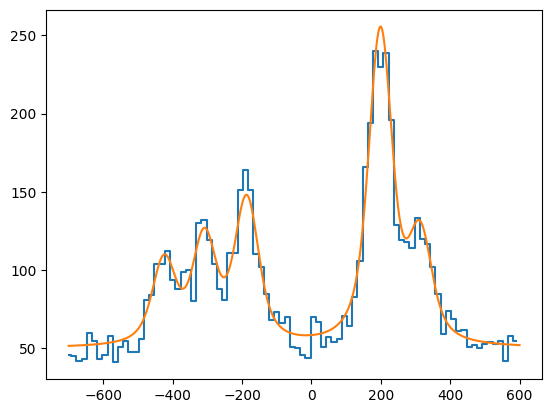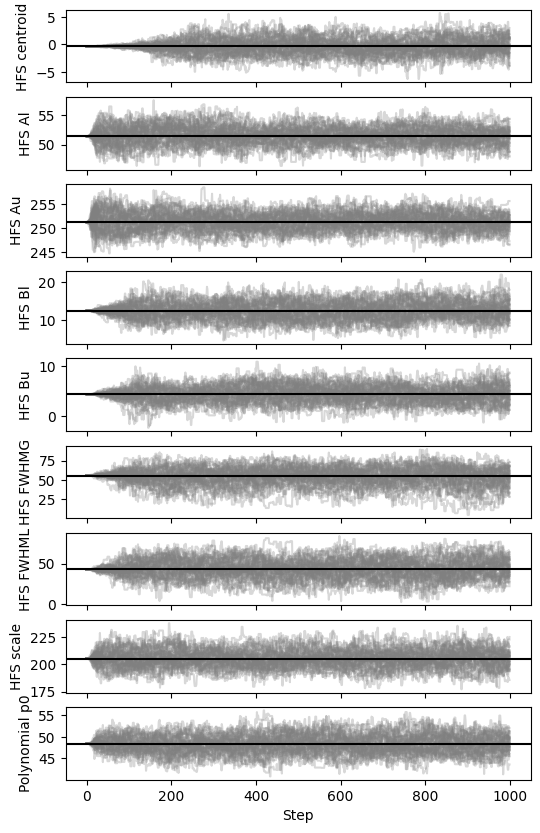Different emcee moves#
The emcee library that is used for the random walk exploration of
the parameter space has some options that are exposed in the SATLAS2
interface. One interesting option is the ability to change the
algorithms used to propose moves. The emcee documentation contains a
tutorial on how and why different moves can be used
here.
The exploration of the parameter space for hyperfine spectra does benefit from this option. The difference between the standard stretch move and the proposed mix of differential evolution move and snooker move will be explored.
import sys
import time
import emcee
import matplotlib.gridspec as gridspec
import matplotlib.pyplot as plt
import numpy as np
sys.path.insert(0, '..\..\..\src')
import satlas2
def modifiedSqrt(input):
output = np.sqrt(input)
output[input <= 0] = 1
return output
Data generation#
The convenience function included in SATLAS2 is used to generate a Poisson distributed spectrum.
A = [50, 250]
B = [10, 5]
C = [0, 0]
I = 1.0
J = [1.0, 1.0]
df = 0
fwhmg = 50
fwhml = 50
scale = 200
bkg = 50
hfs = satlas2.HFS(I, J, A=A, B=B, C=C, df=df, fwhmg=fwhmg, fwhml=fwhml, scale=scale)
bkg = satlas2.Polynomial([bkg])
x = np.linspace(-700, 600, 1000)
data_x = np.arange(x.min(), x.max(), 15)
data_y = satlas2.generateSpectrum([hfs, bkg], data_x)
plt.plot(data_x, data_y, drawstyle='steps-mid')
plt.plot(x, hfs.f(x)+bkg.f(x))
f = satlas2.Fitter()
datasource = satlas2.Source(data_x, data_y, yerr=modifiedSqrt, name='Artificial')
datasource.addModel(hfs)
datasource.addModel(bkg)
f.addSource(datasource)
f.fit()
print(f.reportFit())
[[Fit Statistics]]
# fitting method = leastsq
# function evals = 91
# data points = 87
# variables = 9
chi-square = 72.8990076
reduced chi-square = 0.93460266
Akaike info crit = 2.61552097
Bayesian info crit = 24.8086940
[[Variables]]
Artificial___HFS___centroid: -0.37055045 +/- 1.42164523 (383.66%) (init = 0)
Artificial___HFS___Al: 51.4477619 +/- 1.39705770 (2.72%) (init = 50)
Artificial___HFS___Au: 251.236334 +/- 1.65652941 (0.66%) (init = 250)
Artificial___HFS___Bl: 12.5419832 +/- 2.59229524 (20.67%) (init = 10)
Artificial___HFS___Bu: 4.34080560 +/- 1.74164467 (40.12%) (init = 5)
Artificial___HFS___Cl: 0 (fixed)
Artificial___HFS___Cu: 0 (fixed)
Artificial___HFS___FWHMG: 56.0066443 +/- 10.2656213 (18.33%) (init = 50)
Artificial___HFS___FWHML: 42.4534449 +/- 11.2048829 (26.39%) (init = 50)
Artificial___HFS___scale: 205.225337 +/- 7.32534024 (3.57%) (init = 200)
Artificial___HFS___Amp0to1: 0.2666667 (fixed)
Artificial___HFS___Amp1to0: 0.2666667 (fixed)
Artificial___HFS___Amp1to1: 0.2 (fixed)
Artificial___HFS___Amp1to2: 0.3333333 (fixed)
Artificial___HFS___Amp2to1: 0.3333333 (fixed)
Artificial___HFS___Amp2to2: 1 (fixed)
Artificial___Polynomial___p0: 48.4270596 +/- 1.97001650 (4.07%) (init = 50)

Standard emcee move#
The normal move used by emcee is called the StretchMove, and is used
by not specifying any specific moves at all
stretchfile = 'stretchmove.h5'
f.fit(method='emcee', filename=stretchfile)
100%|████████████| 1000/1000 [00:28<00:00, 35.70it/s]
The chain is shorter than 50 times the integrated autocorrelation time for 9 parameter(s). Use this estimate with caution and run a longer chain!
N/50 = 20;
tau: [52.18497247 57.73151625 50.61482182 58.94721213 55.18218592 53.97033804
51.2988931 56.19765179 49.45745584]
The warning here shows that, in order to get good estimates, more
samples are recommended. For more information, see the emcee
documentation. However, the important detail here is the list of
autocorrelation times that is estimated here, which is about 50-60
steps.
fig, axes = satlas2.generateWalkPlot(stretchfile)
fig.set_size_inches(6, 10)

Here, the burn-in is quite long for several parameters. If possible, avoiding long burn-ins is very useful to increase useful computation time.
Using differential evolution moves#
Starting from version 3, emcee has a Moves interface where the
proposal for the random walk can be changed. In addition to specifying
another algorithm, a selection of moves can be given along with a float
that represents the chance the algorithm is selected. Giving an ensemble
of move proposals in this way can improve overall performance.
As illustrated in the linked documentation, a combination of DEMove and DESnookerMove can perform better in highly dimensional or lightly multimodal distributions. Both of these descriptions can be well applied to the fitting of hyperfine spectra.
combinationfile = 'combination.h5'
f.revertFit()
f.fit(method='emcee', filename=combinationfile, sampler_kwargs={'moves': [
(emcee.moves.DEMove(), 0.8),
(emcee.moves.DESnookerMove(), 0.2)
]})
100%|████████████| 1000/1000 [00:28<00:00, 35.65it/s]
The chain is shorter than 50 times the integrated autocorrelation time for 9 parameter(s). Use this estimate with caution and run a longer chain!
N/50 = 20;
tau: [25.79202768 28.04787132 31.15895649 27.02757601 27.06688899 32.62843194
33.30301554 29.44226374 30.75024705]
As with the previous case, the recommendation is that a longer chain is used. However, the autocorrelation time is much shorter, 20-30 steps instead of the previous 50-60 steps. This corresponds to a walk that shows a much lower burn-in time.
fig, axes = satlas2.generateWalkPlot(combinationfile)
fig.set_size_inches(6, 10)

This is clearly reflected in the resulting walk. Experimentation with the exact mixture of Moves can result in even better performance. Since SATLAS2 relies on the interface provided by emcee, any future Moves that are introduced can automatically be used in SATLAS2 for sampling.